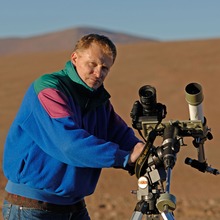Serge Brunier | |
|---|---|
 | |
| Born | 1958 Paris, France |
| Occupation(s) | Photographer, reporter, and writer |
Serge Brunier (born 1958 in Paris) is a French photographer, reporter, and writer who has specialized in popular depictions of astronomical subjects.
Serge Brunier | |
|---|---|
 | |
| Born | 1958 Paris, France |
| Occupation(s) | Photographer, reporter, and writer |
Serge Brunier (born 1958 in Paris) is a French photographer, reporter, and writer who has specialized in popular depictions of astronomical subjects.
Brunier works together with the magazine Science et Vie and is a columnist of the radio station France Info. He has written a large number of illustrated works regarding astronomy.
He campaigns for an exploration of the Solar System through unmanned spacecraft, but fights against crewed spaceflight. [1]
In his illustrated book Solar System Voyage, he describes the situations on the planets, and how a hypothetical voyager would experience them.
Brunier created a panoramic photograph of the Milky Way in the Atacama desert over two years; it was shown at his first exposition in the Monte Carlo Casino in 2006, and in 2007 at the Palais de la Découverte in Paris with its one hundred million pixels fit onto 144 square meters.
The International Astronomical Union has named the asteroid 10943 after Brunier in recognition of his services in the advancement of science. [2]
Published in 2005 at Firefly Books Ltd., Brunier's Concise Atlas of the Stars helps to identify specific stars, nebulas, and galaxies by large photographs and transparent overlays, in particular of the most important constellations. It informs about location, luminosity, and dimensions as well as about when a specific object of the night sky can best be observed. [3]